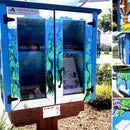Introduction: Water Coasters
Resin is a wonderful media to work with because you can make it look like so many other things. In this tutorial, I'll show you how to make 2-part resin look like water. I'll be making coasters, but you can use the techniques in any shape molds.
Step 1: What You Need
2-part epoxy resin
Blue resin dye
Optional: 2nd shade of blue dye
White resin dye (opaque)
Molds - preferably something low and flat (I'm using round coaster molds)
Toothpicks, stirrers, newspaper and/or parchment paper to protect surface, mixing cups
Gloves, ventilation, mask if indoors
Flat, sturdy work board (cover with wax paper)
Step 2: Mix Resin
Mix enough clear resin (according to package directions) to fill your mold(s) about 2/3 of the way.
Then pour some of the clear mixed resin into 2 or 3 mixing cups. Color one portion with white and one portion with light blue. You can make a 3rd portion with a different shade of blue if you want. Leave the rest of the clear resin alone for now.
Let all the epoxy rest for 10-15 minutes to let bubbles pop, and the resin to thicken a little.
Step 3: First Pour
When your resin is slightly thickened, like honey, it's time to pour.
Pour some of each color you mixed (use very little white for now) in sections or strips into each mold.
Then add some more blue dye to the blue to make a dark blue.
Add some dark blue to the mold.
Continue adding more clear or blue until the mold bottom is barely covered.
Step 4: Water Base
The colors will blend together and you'll see a water pattern form.
Step 5: White
As the resin continues to thicken slightly, additional colors will be more distinct.
Add the white resin in drips or patterns by pouring some directly into the blue base.
You can swirl the colors together with a toothpick.
Step 6: Swirl
Create patterns with the clear, white, and blues. The colors will continue to blend as long as the resin is still liquid. Make sure not to overmix or you'll end up with a mostly solid color. You can still add more of any color to get a balance you like.
Step 7: Clear
Adding more clear will give you the look of translucent water and add depth to your artwork.
Add more clear slowly and gently until the molds are about 2/3 full.
Step 8: Blend
With a toothpick, drag some of the blue into the clear. Again, they will continue to blend while the resin sets, so use a light touch when mixing.
When you like your water patterns, it's time to let the resin cure. Cover your molds with a box and resist touching or moving them until the next day.
Note: Yes, that's a big rock holding the box down. I work outside and it gets windy at night :-)
Step 9: First Cure
The next day, remove the box and test to see if the resin is cured. It doesn't need to be fully cured at this point. Just solid enough to add another layer.
Important: Do NOT remove resin from the molds!
Step 10: Next Day, Next Layer
Mix enough clear resin to fill your molds the rest of the way.
Divide the clear batch in half and tint one portion very light blue.
Step 11: Pour Again
Note: For the next 2 steps work on the flattest, most level surface possible. I like to put my molds on a flat board so I can adjust the leveling if needed.
Pour some light blue and some clear into each mold until the resin reaches the top. You can mix these a little if you want, or just let the two colors blend on their own.
Step 12: Dome and Set
Pour a small amount of clear, one drop at a time, until the resin forms a slight dome.
Look and see if the resin is level (though not flat). If it seems to be collecting on one side, adjust the height of your work board with a little paper or a few playing cards.
Protect your molds with a box again and let cure overnight.
Step 13: Unmold!
Before you take your pieces out of the molds, make sure the resin is fully cured. It should be hard and glass-like. If not, leave them for an additional day.
If they are fully hardened, gently pop your resin out of the molds.
You'll see how you get the whole water effect, and how the other side looks once they are out.
Step 14: A Little Light, a Lot of Depth
How much you see through the cured resin depends on how much clear you used, and how opaque you made the blues.
Step 15: Backing
For this project I prefer not to add a cork backing. This has two advantages. First, the coasters remain see-through. And second, they are two-sided and you can display either side.
Properly cured resin is safe on most surfaces, so a backing is optional.
Step 16: Finish
My coasters came out ready to use, but if yours have any edges or imperfections you don't like, here are 2 ways to fix them.
1) Sand any sharp or rough edges. This will take away the shine, so keep sanding to a minimum, using the finest grit you can.
and/or
2) Add a thin coating of clear resin to the entire surface of an imperfect side. Cure flat and make sure resin doesn't drip over the edges. You can opt to use UV resin for this if you want.
I hope you enjoyed this tutorial! Please think about posting your projects below - I'd love to see how they turn out :-)

Second Prize in the
The Elements Speed Challenge













